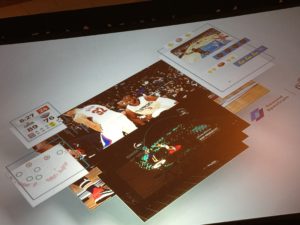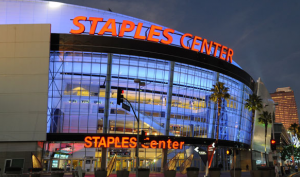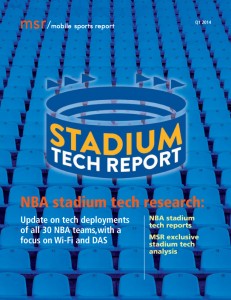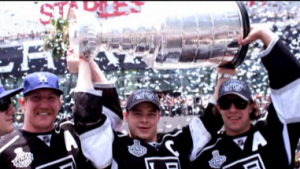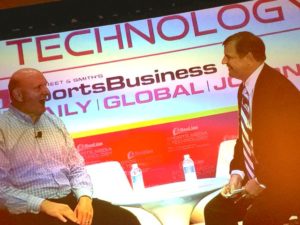
Clippers owner Steve Ballmer (L) talks with John Ourand at the Sports Media & Technology conference. Credit all photos: Paul Kapustka, MSR (click on any photo for a larger image)
There was no dancing through the spotlights, but even in a sit-down setting you couldn’t hide Ballmer’s enthusiasm for technology, now focused on improving the fan experience for watching NBA basketball games, specifically those involving the Los Angeles Clippers, the team Ballmer now owns.
“I am excited for the future of technology and how it could make it REALLY more fun to watch sports,” Baller said to interviewer John Ourand, a writer with Sports Business Journal, the hosts of the 2016 NeuLion Sports Media & Technology conference held at the Manhattan Beach Marriott. If you’ve ever heard Ballmer speak live you know the voice pitch that escalated on that “REALLY” part, a volume increase guaranteed to ensure you’re paying attention.
Now one of the most visible NBA owner-fans, Ballmer told event attendees Wednesday how his team’s new rights deal with Fox’s regional sports network would help the Clippers experiment with more innovative viewing options, including over-the-top streaming game broadcasts.
Watching the game through a player’s view
But put aside for a moment the concerns about old-school broadcast rights — according to Ballmer what he really wanted out of the most-recent deal was breathing room to try new things, like having game views with statistics and other information overlaid or available in pop-out windows; or different camera views, including a VR-like view of the game from a player’s eyes.
“We needed a relationship that would allow us to innovate,” said Ballmer of the recent media deal, one where he dismissed the final dollar figure [worth $50 million to $55 millon per season] as “money is just an arm-wrestle.” Instead of crowing about getting piles of dough for TV rights, Ballmer was clearly more excited about ideas like being able to have player fantasy stats super-imposed over that player’s jersey while live action went on, among other plans.“I want to watch a game as [Clippers point guard] Chris Paul, to see what he sees,” Ballmer said. “That would be a cool view of a game.”
Meet the new boss, different than the old boss
While such ideas are not completely new — others in and around sports have been thinking up such ideas and even trying them out — what’s different with the Clippers and the NBA is Ballmer’s energy, and the ability to not have to care about making money right away given his uber-billionaire wealth. I never worked for Microsoft or Ballmer but from the outside looking in it was pretty easy to see that Ballmer has never been a sit-around-and-wait kind of guy. When talking about the excitement of working with innovative sports-tech firms like Second Spectrum and NeuLion on his player’s-eye cam idea, Ballmer didn’t hesitate to put a timeline on the project.
“I’m going to be highly, highly, HIGHLY disappointed” if the Chris-Paul view isn’t available in 3-4 years, Ballmer said, laughing that it’s always best to put public pressure on engineers to get them to deliver more quickly. And while he’s frustrated by the delays caused by long-term rights deals, the opportunity to rework the Clippers’ local rights gave him a door to push open. And like always, Ballmer didn’t come in quietly.
“I didn’t want to wait to get started,” Ballmer said. “I’ve got a passion for the technology and we were at the end of the contract so… BOOM! Let’s go ahead and move forward.”
Ballmer also talked about the idea of building a new Clippers arena somewhere down the road, and about using technology to let fans at games have a better experience, like being able to upgrade your seat during the event. Dreaming about a new venue specifically built for basketball, Ballmer thought out loud about the benefits of having fans closer to the action, with an increased list of tech-aided amenities.
“The technology of arena design is advancing, too,” Ballmer said, pointing to such new structures as Sacramento’s Golden 1 Center. “You have to figure out how to serve the modern fan.” Will Ballmer in charge, it’s a safe bet that Clippers fans may be among the first to be so served.
